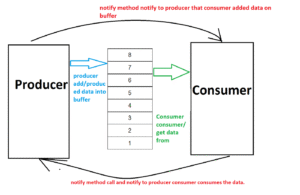Classical Problems — Producer-Consumer, Dining Philosophers, Readers-Writers
Classical synchronization problems help illustrate the real-world challenges faced in process coordination and resource sharing in concurrent systems. They form the foundation for understanding how operating systems handle critical sections, resource contention, and deadlock prevention.
Let’s explore three of the most important classical problems: Producer-Consumer, Dining Philosophers, and Readers-Writers.
1. Producer–Consumer Problem
Concept:
This problem involves two types of processes—producer and consumer—that share a common, finite-size buffer.
- The producer adds (produces) items into the buffer.
- The consumer removes (consumes) items from the buffer.
- They must not access the buffer simultaneously, and the producer must wait if the buffer is full; the consumer must wait if it’s empty.

Challenges:
- Race conditions can occur if both try to modify the buffer at the same time.
- Must ensure mutual exclusion, synchronization, and bounded buffer access.
Real-life analogy:
A restaurant kitchen where chefs (producers) prepare meals and place them on a counter. Waiters (consumers) take meals to customers. If the counter is full, chefs must wait. If it’s empty, waiters must wait.
2. Dining Philosophers Problem
Concept:
This classic problem is used to demonstrate deadlock and resource contention.
- Imagine five philosophers sitting around a circular table.
- Each has a plate of food and a chopstick on either side.
- To eat, a philosopher must pick up both chopsticks (left and right).
- Chopsticks are shared resources, so only one philosopher can use each at a time.

Problems Highlighted:
- Deadlock: If all philosophers pick up the left chopstick at the same time, none can pick up the right—resulting in a deadlock.
- Starvation: One philosopher may never get both chopsticks if others keep eating.
- Concurrency Control: Preventing simultaneous access to shared chopsticks.
Goal:
To find a solution that allows all philosophers to eventually eat without deadlock or starvation, often using techniques like semaphores, mutexes, or resource hierarchy.
3. Readers–Writers Problem
Concept:
This problem deals with a shared database (or resource) where:
- Readers only need to read the data (no changes).
- Writers can modify the data.

Rules:
- Multiple readers can read at the same time.
- But when a writer is writing, no other reader or writer should be accessing the data.
Versions:
- First Readers–Writers Problem: No reader should be kept waiting unless a writer has already acquired the lock.
- Second Readers–Writers Problem: If a writer is waiting, it should be given priority over new readers.
Key Issues:
- Mutual exclusion for writers.
- Fairness between readers and writers.
- Preventing reader starvation or writer starvation depending on the strategy used.
Real-life analogy:
Think of a shared Google Doc. Multiple users can view (read) it at once, but only one person should edit (write) at a time to avoid conflicts.